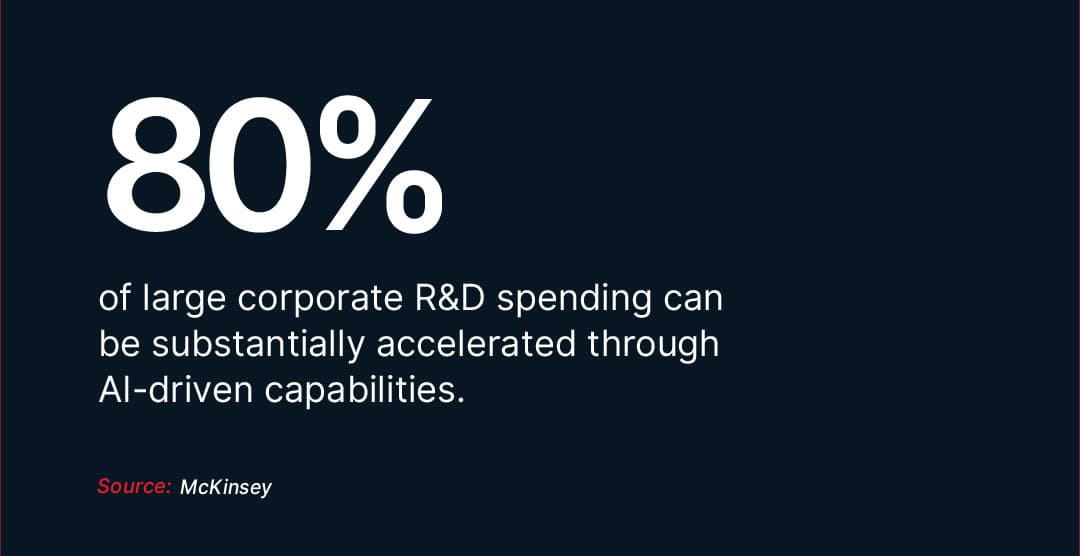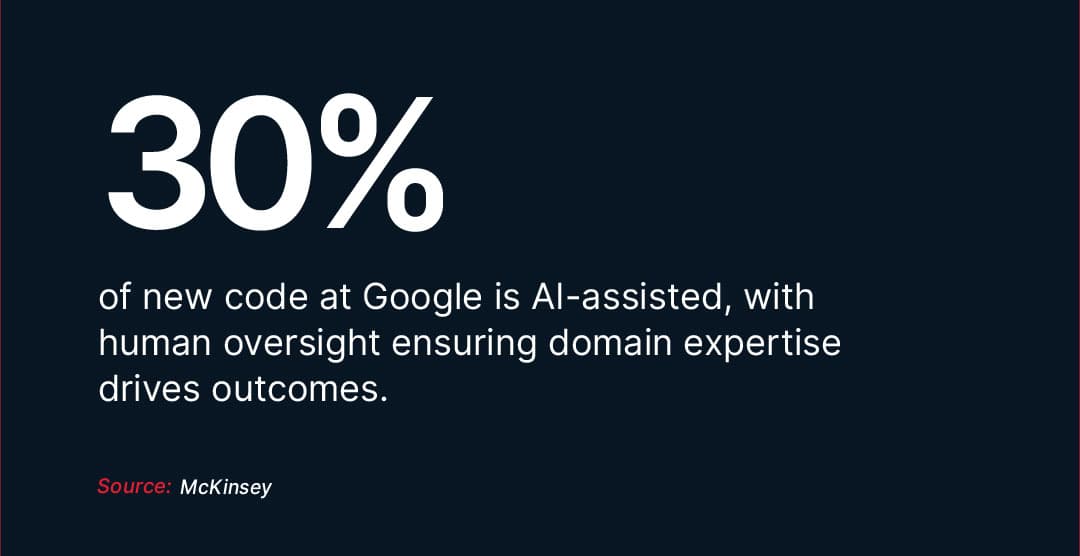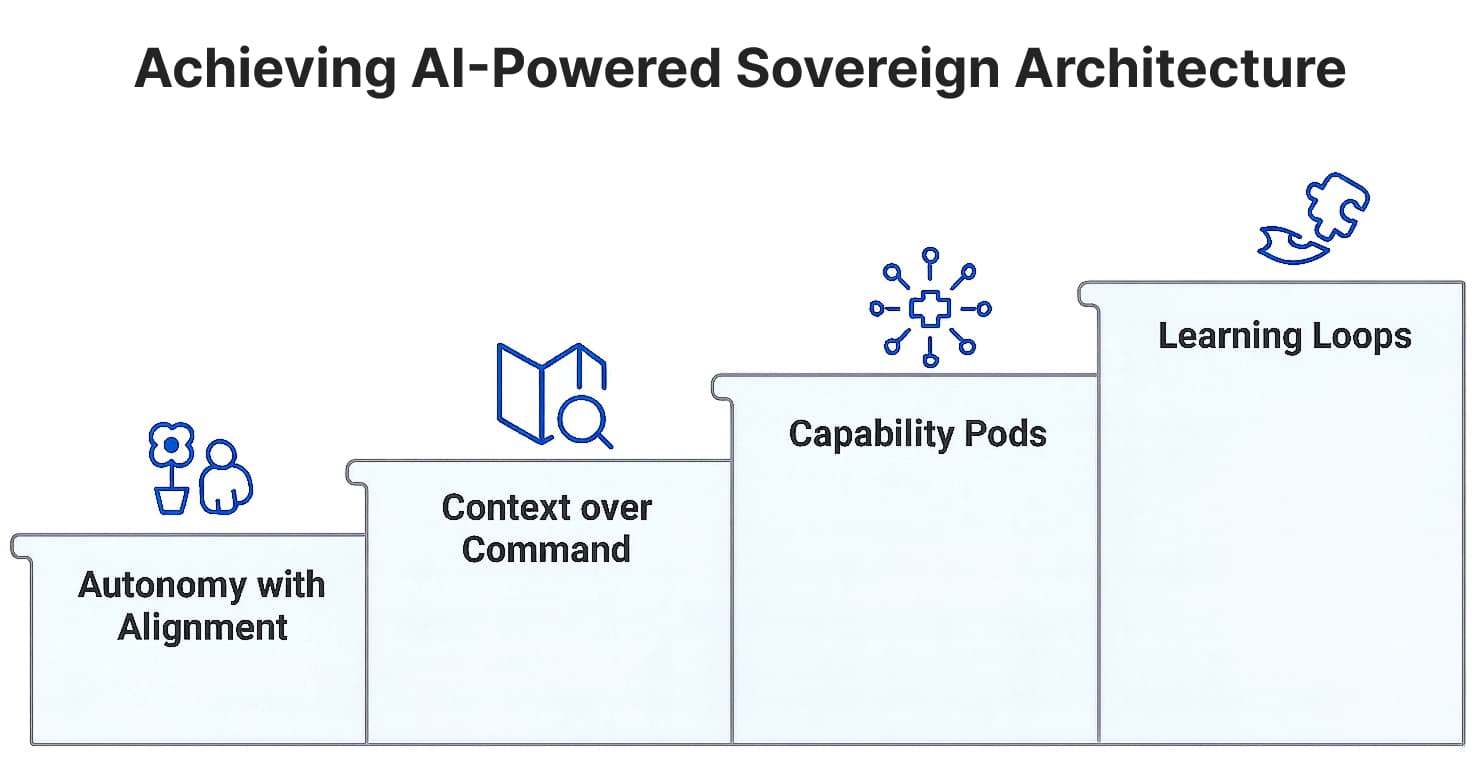The Distributed Advantage - How Sovereign Enterprises Architect Teams for the AI Era
18 November, 2025
Key Takeaways:
- Enterprises that design AI-native structures turn intelligence into a distributed network, embedding capability where data, decisions, and expertise converge.
- Forward Deployment Engineers and cross-functional pods amplify human-AI collaboration, accelerating learning cycles and compounding organizational capability.
- Modern GCCs evolve into AI-powered capability centers (AICCs), creating proprietary advantages that external advisors cannot replicate.
- True innovation sovereignty requires structures that enable autonomy, alignment, and AI-driven intelligence at the edges, where enterprise strategy meets operational execution.
There seems to be a recurrent pattern in boardrooms everywhere; the CTO approves AI budgets, teams deploy tools, dashboards populate with metrics. Yet when the CEO asks how efficient the solutions are, how well the processes work, and about measurable efficiency gains; the answer remains unclear.
The carefully laid out plan for digital transformation seems elegant at first; the tools work, the teams deliver, but the intelligence never becomes institutional. Knowledge flows through the organization like water through a sieve, and by the time insights crystallize into strategy, the market has already shifted.
The previous blog revealed how Conway's Law makes organizational structure the true constraint on innovation capacity. If enterprises cannot innovate faster than their design allows, then the question becomes, what does t he structure that enables AI-native innovation actually look like?
The answer is not what most enterprises expect. It is not a pyramid, refined through better processes. It is not even a matrix, optimized through clearer roles. It is a nervous system, where intelligence lives at the edges and coordination happens through shared context instead of hierarchical control.
The New Organizational Blueprint: AI-Native by Design
For decades, organizational design followed a predictable logic. Expertise flowed from the top down. Decisions escalated upward. Innovation required approval chains. Then AI distributed analytical capability across the entire workforce, breaking the old logic.
Conway's Law reveals why structure determines capability. If organizations design systems that mirror their communication patterns, then enterprises seeking AI-native capabilities must architect structures that mirror distributed, continuously learning intelligence (Conway, 1967). The shift is measurable.
AI substantially accelerates R&D across industries, accounting for 80% of large corporate R&D spending. In pharmaceuticals, AI-driven internal capabilities enhance R&D throughput by more than 100%. In electronics, AI nearly doubles the pace of product design (McKinsey, 2025). These gains accrue only to enterprises that own the intelligence, instead of renting it.
Learn More: Strategic Ownership- Rewriting the AI Buy–Build Debate

The GE Model: From Simulation to Sovereignty
General Electric demonstrates this through AI-powered simulations for jet engine development. By building internal AI-driven simulation capabilities, GE engineers predict material behavior under extreme conditions, accelerating design iterations while improving product quality. The intelligence compounds with each engine cycle, creating institutional knowledge competitors cannot access (GE Aerospace, 2024).
The Google Model: Human Oversight at Scale
At Google, 30 percent of all new code is generated with AI assistance, but human oversight remains critical. This human-AI collaboration model, where AI augments rather than replaces domain expertise, has become fundamental to how work is performed (McKinsey, 2025). The statistic is impressive. The structure behind it is strategic.

Breaking Down Silos Through Cross-Functional Intelligence
Organizations with strong innovation cultures enhance decision-making by optimizing initiatives across the enterprise rather than within isolated functions (McKinsey, 2024). When AI democratizes analytical capability, centralized approval chains become bottlenecks. Departmental boundaries become friction points.
Today, modern GCCs have evolved into embedded AI capability centers where human expertise and machine intelligence compound into capabilities external advisors cannot replicate. Success depends on cross-functional collaboration and shared incentives that AI-native workflows enable (McKinsey, 2024).
This is organizational design for innovation in practice.
But cross-functional departments cannot thrive on structure alone. They require domain experts who frame problems rather than just execute solutions and who bridge business context with AI systems. This is where organizational design meets talent architecture.
Learn More: The Sovereign Enterprise - Reclaiming Innovation in the Post-Consulting Era
Forward Deployment Engineers: The Structural Choice
Forward Deployment Engineers (FDEs) are more than a job title; they are an agile organizational design choice that determines whether AI amplifies human capability or simply automates existing workflows.
Traditional hierarchies isolated strategy, expertise, and execution. FDEs bridge these gaps, embedding in business units to link domain knowledge with AI systems, a structural choice that drives strategic advantage.
Unlike developers who execute specifications, FDEs focus on problem framing. They translate strategic intent into adaptive system design, using AI to automate repetitive work while focusing human intelligence on problem discovery.
High-performing innovators win by architecting operating models where talent and organizational design work as a single system (McKinsey, 2023).
This is building innovation capability through structure. Not through hiring more people, but by redesigning how teams work.
Learn More: The Great Insourcing - Why Enterprises Are Building What They Used to Rent
When AI capability embeds where operational reality lives rather than sitting in isolated innovation labs, enterprises gain freedom to explore hypotheses without procurement delays. They test solutions without vendor dependence. They accelerate learning cycles inside their own environment. Context stays. Intelligence compounds. Competitive advantage becomes proprietary rather than rented.
Where AI-Native Intelligence Lives: The Geographic Advantage
For two decades, geography meant cost arbitrage. AI inverted that logic. Geography now means accessing talent pools previously locked out of enterprise innovation.
Traditional enterprises competed for the same limited talent in expensive hubs. AI-native enterprises tap global talent where AI skills concentrate naturally.
Insilico Medicine exemplifies this shift. By establishing AI research hubs where computational biology talent concentrates, their in-house Pharma.AI platform identified a drug candidate for fibrosis in 46 days, a process typically requiring years (Insilico Medicine, 2024).
This accelerated capability exists because geographic placement enabled access to AI-native researchers who build intelligence infrastructure internally, compounding with each discovery cycle.
Learn More: Owning Intelligence - The Case for Enterprise Sovereignty in the AI Era
The Four Pillars of AI-Powered Sovereign Architecture
Every transformation leader eventually confronts the same question: what does sovereign architecture look like in practice?

It rests on four AI-powered principles:
- Autonomy with Alignment: Decision-making happens locally, within global guardrails. Leaders adopt a gardener's mindset, nurturing innovation where it already exists rather than imposing rigid plans (McKinsey, 2024).
- Context over Command: Intelligence operates at the point of work, continuously refined by machine learning from real operational cycles.
- Capability Pods over Departments: Teams are organized around outcomes and problem-solving instead of functional silos.
- Learning Loops over Linear Workflows: Structure itself becomes adaptive, absorbing insights through AI to continuously evolve capabilities.
" In sovereign enterprises, architecture is the engine of innovation, translating strategy into compounding organizational advantage. "
From AI-Ready to AI-Native Operations
The difference between AI-ready and AI-native is structural rather than technological.
Organizations become AI-ready by making structural adjustments that integrate AI into processes (McKinsey 2024). This is the modern enterprise operating model in action. But most enterprises stall here.
Traditional structures cannot adopt this model. External dependencies create strategic vulnerabilities. Internal capabilities compound over time. True competitive advantage comes from what you own, not what you rent.
Where vendor-dependent intelligence evaporates when contracts end; internally embedded capability centers create systems that accelerate with every deployment, models that learn organizational nuance, and intelligence loops that remain proprietary assets.
Learn More: Beyond the Pyramid- AI Innovation Sovereignty and the End of Consulting Dependence
" Innovation sovereignty, in practice, is the strategic imperative to build organizational capability internally rather than renting it externally. "
Reclaiming the Architecture of Intelligence
Conway's Law revealed a truth most enterprises learn too late. Organizations build what their structure allows. No more. No less.
Sovereign enterprises invert this logic. They architect a structure for what AI enables them to build: distributed intelligence that learns, compounds, and adapts faster than competitors can plan.
The question is no longer whether AI will reshape organizations. It is who will own the intelligence that emerges.
The enterprises that embed AI capability at functional cores, that structure teams for continuous learning, and that treat geography as a talent strategy rather than a cost center will compound sustained advantage.
Those that rent intelligence through vendors, that bolt AI onto hierarchical structures, and that treat AI as a tool rather than an operating system will find themselves perpetually behind.
Ready to build your AI- powered sovereignty engine?
Partner with CodeNinja to establishAI capability centers that embed intelligence, amplify innovation, and transform enterprise operations into a compounding system of learning and competitive advantage.
Bibliography
Conway, Melvin E. 1967. "Conway's Law." Accessed October 2025. http://www.melconway.com/Home/Conways_Law.html
GE Aerospace. 2024. "GE Aerospace Deploys AI-Driven Inspection Tool to Maximize Narrowbody Engine Time on Wing." GE Aerospace Press Release. https://www.geaerospace.com/news/press-releases/ge-aerospace-deploys-ai-driven-inspection-tool-maximize-narrowbody-engine-time-wing.
Insilico Medicine. 2024. "AI-Driven Drug Discovery Platform." Insilico Medicine.
McKinsey & Company. 2023. "Creating High-Performance Innovation Teams at Scale." McKinsey Insights. https://www.mckinsey.com/capabilities/strategy-and-corporate-finance/our-insights/creating-high-performance-innovation-teams-at-scale.
McKinsey & Company. 2024. "Companies with Innovative Cultures Have a Big Edge with Generative AI." McKinsey Insights. https://www.mckinsey.com/capabilities/strategy-and-corporate-finance/our-insights/companies-with-innovative-cultures-have-a-big-edge-with-generative-ai.
McKinsey & Company. 2024. "How Innovative Companies Leverage Tech to Outperform." McKinsey Insights. https://www.mckinsey.com/capabilities/strategy-and-corporate-finance/our-insights/how-innovative-companies-leverage-tech-to-outperform.
McKinsey & Company. 2024. "The Committed Innovator: The Power of Design." McKinsey Insights. https://www.mckinsey.com/capabilities/strategy-and-corporate-finance/our-insights/the-committed-innovator-the-power-of-design.
McKinsey & Company. 2024. "The Learning Organization: How to Accelerate AI Adoption." McKinsey Insights. https://www.mckinsey.com/capabilities/strategy-and-corporate-finance/our-insights/the-learning-organization-how-to-accelerate-ai-adoption.
McKinsey & Company. 2024. "The Next Innovation Revolution, Powered by AI." McKinsey Insights.https://www.mckinsey.com/capabilities/quantumblack/our-insights/the-next-innovation-revolution-powered-by-ai.
McKinsey & Company. 2025. "R&D Recharged by AI." McKinsey Featured Insights.https://www.mckinsey.com/featured-insights/week-in-charts/r-and-d-recharged-by-ai.
McKinsey & Company. 2025. "Transforming R&D with AI: Breaking Barriers and Boosting Productivity." McKinsey Talks Operations. https://www.mckinsey.com/capabilities/operations/our-insights/transforming-r-and-d-with-ai-breaking-barriers-and-boosting-productivity.
FAQs
Q1: How can enterprises measure whether their AI capability centers are actually compounding organizational intelligence?
Metrics should go beyond tool adoption. Track innovation velocity, cross-functional knowledge flow, and AI-driven decision impact. Effective organizational design ensures intelligence compounds internally rather than being siloed or outsourced.
Q2: Why do traditional hierarchies fail to capture the full potential of AI investments?
Hierarchies constrain information flow and decision-making. Even advanced AI loses strategic impact if it’s embedded in siloed structures. Enterprise innovation thrives when AI capability centers operate within distributed, learning-oriented architectures.
Q3: How does embedding Forward Deployment Engineers impact ROI on AI investments?
By positioning FDEs at functional cores, enterprises reduce redundancy, accelerate learning cycles, and generate proprietary intelligence. This transforms AI and organizational design investments into sustainable enterprise innovation rather than transient, vendor-dependent gains.
Q4: Can GCCs evolve into AI-native hubs without redesigning core organizational structures?
Modern global capability centers must shift from transactional execution to embedded innovation engines. Only through distributed teams, aligned autonomy, and capability pods can AI investments compound into proprietary intelligence rather than rented outputs.
